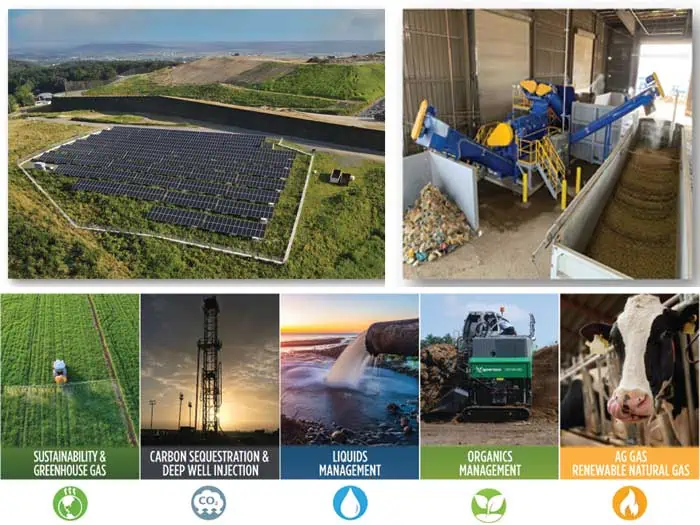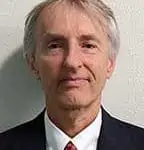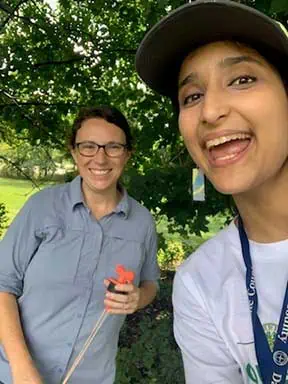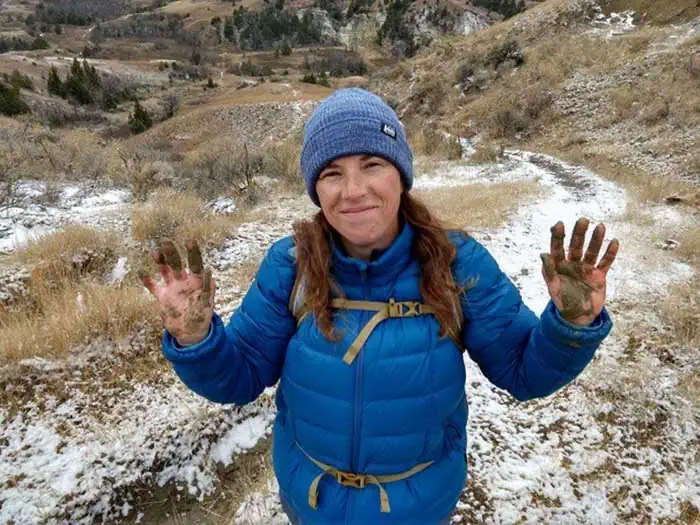


Landfill owners, operators, and engineers have long dreamed of using landfill acreage for more than disposal, and that’s just what the Lanchester Landfill in Pennsylvania is doing. Many disposal companies and municipalities are already controlling waste rather than seeing it go into landfills, take a moment to see the innovative Republic Inc. solutions.
Sustainability in the waste industry is becoming a reality with new recycling and reuse technologies, renewable energy, public/private and organizational coordination, and the backing of industry associations.
Odor attribution is a complicated process when nuisance odors are intermittent and come from more than one source. Today’s blog discusses technological advances in olfactometers and processes to investigate and resolve industrial or agricultural odors.
To investigate odors, SCS begins by reviewing odor complaints for patterns based on location, time of day, the month of the year, and local wind conditions. We then use a site survey to identify candidate sources of odor that may contribute to the region’s odor complaints. Next, we assess the relative contributions of the most probable sources identified by collecting odor samples at/near each source and upwind, downwind, and crosswind. Traditionally, a limited number of odor samples could be collected daily in Tedlar® bags and shipped overnight to a certified laboratory for analysis by an odor panel. The odor panel uses an olfactometer to sniff air samples at varying dilutions for odor concentration, character, and intensity following American Society for Testing and Materials (ASTM) methods.
In certain situations, however, using a portable olfactometer in the field is more efficient. SCS recently implemented the Scentroid SS400 Six Station Portable Olfactometer Odor Lab for large odor studies. The Scentroid SS400 is the world’s only portable six (6) panel olfactometer compliant with European Standard EN 13725/2003 and ASTM E679-04 and is compact for easy transportation and deployment in remote locations. The Scentroid SS400 allows us to:
By having more data, our SCS professionals gain insight into complex nuisance odors and propose targeted mitigation measures that reduce odor concentrations downwind. With over 30 years of experience resolving odors from landfills, wastewater treatment plants, composting facilities, agricultural and manufacturing facilities, we’re confident we can help your facility come up smelling like roses too.

Additional Resources:
SCS Engineers periodically prepare SCS Technical Bulletins – short, clear summaries of rules, plans, and standards. In 2021, ASTM International published an updated consensus guidance document for evaluating environmental conditions at properties involved in commercial real estate transactions.
This SCS Technical Bulletin for the revised E1527-21, Standard Practice for Environmental Site Assessments: Phase I Environmental Site Assessment Process addresses definitions and terminology, clarifies industry practice for the historical records review of the subject and adjoining properties, and provides for updates and additions to appendices, report outlines, and other collateral.
Our updated edition now includes the revised guidance speaks to the business risk associated with emerging contaminants, such as Per- and polyfluoroalkyl substances (PFAS).
Read, share, download the A New Standard Practice for Phase I Environmental Site Assessments Tech Bulletin here.
For more information about Environmental Due Diligence, please visit our website.
SCS Engineers welcomes Ryan D. Francis as Environmental Services Project Director in Texas. He investigates and remediates petroleum or chlorinated solvent-contaminated properties for continued use or beneficial reuse.
Mr. Francis is a licensed professional geologist with over 16 years of experience, including senior management of a nationwide portfolio of petroleum storage tank closures; technical and project management of petroleum soil and groundwater site investigations and remediation; third-party technical review; property administrative controls; and serving as the geologist-on-record for multiple environmental projects in Arkansas, Louisiana, and Texas.
Ryan supports national clients in the logistics and oil & gas businesses, focusing on midstream and downstream infrastructure, such as underground and above-ground storage tanks, pipelines, and aging infrastructure; many in the U.S. are over 75 years old. He works closely with local and state environmental quality agencies to ensure appropriate environmental protection for each project and to support clients in complicated cases involving multiple responsible parties.
“At SCS, we guide our clients through the regulatory framework as it impacts each project’s work, whether infrastructure or properties, states Vice President Jeff Reed. “Ryan’s deep knowledge of midstream and downstream environmental regulations and ability to target what is most appropriate for the specific environmental conditions is a valuable addition to our O&G and Remediation teams.”
Meet Ryan D. Francis.
Landfill owners, operators, and engineers have long dreamed of using landfill acreage for more than disposal. Many disposal companies and municipalities are already planning to control waste rather than seeing it go into landfills or using less sustainable plans to truck it far away. Those dreams are becoming a reality using sustainability and solid waste master planning. Coupled with new recycling and reuse technologies and organizational coordination, our speakers are making the evolution happen.
Thursday, April 6
2:00 pm Eastern Time, for 1 hour
Learn More and Register for Sustainable Directions in the Waste Industry Here
CAN’T MAKE THE LIVE SESSIONS? NO PROBLEM. RSVP, AND WE’LL SEND YOU THE RECORDING.
We hope you can join SCS Engineers for our next client webinar and open forum. Feel free to share this invitation with others interested in learning more about what leading organizations are doing to become more sustainable.
We encourage you to share this invitation – please do not share your Zoom registration confirmation – it is unique to you for Certificates of Attendance.
Learn More and Register for Sustainable Directions in the Waste Industry Here
Environmental due diligence is a form of proactive environmental risk management typically conducted before purchasing, selling, or leasing a property or business. Due diligence investigations can help prevent costly environmental liabilities by identifying them early in the transaction, thereby protecting all parties’ interests. There is an increased opportunity for significant cost-savings when the hired consultant accounts for tangential aspects during their investigation.
Environmental due diligence encompasses tangential aspects that are not the primary focus of the investigation. Aspects such as these may indirectly impact the environmental risks or liabilities associated with the property or business or the transaction’s overall feasibility or value.
Tangential Aspects of Environmental Assessment: A Case Study
A major oil company requested environmental due diligence for a large property acquisition. The property acquisition was part of a larger company acquisition and involved hundreds of oil and gas well locations, facilities, tanks, and equipment. It was necessary to modify the Phase I assessment for the work. Of the hundreds of well locations, 50 were chosen for Phase I work and field verification. According to the consultants, any environmental liabilities exceeding $2 million must be identified during this evaluation. Phase I examined the locations of wells for potential environmental liabilities, such as petroleum releases, but did not examine the wells themselves. Even though the consultants were experts in evaluating the condition of oil and gas wells, the oil company addressed this aspect of the investigation in-house. The company did not consider the tangential legal implications, liability for plugging costs, potential impacts on property value, and potential penalties for non-compliance with regulations.
Many wells excluded from the consultants’ due diligence were over 50 years old and out of operation. The company’s in-house investigators did not perform a field review. The result was an underestimation of the number of wells that required plugging and their associated costs. The estimate for plugging a well was between $20,000 and $30,000 per well. The plugging costs for this transaction were much higher, ranging from $80,000 to $120,000 per well, resulting in a $42 million increase. The oil company made a mistake in thinking the plugging costs were insignificant. Environmental due diligence should always include tangential factors.
Additional examples of tangential aspects of environmental due diligence might include the following:
The information obtained during or upon completing an investigation can inform negotiations and contractual arrangements between the parties involved in the transaction. Environmental consultants could spot some issues big enough to kill a deal. Other issues may allow buyers to adjust the purchase price or negotiate an indemnity to shift financial responsibility for environmental risk. It may also be possible to purchase environmental insurance for sufficient financial protection.
The specific steps involved in environmental due diligence depend on the type and scope of the transaction, as well as any applicable regulations or guidelines. Consult an experienced environmental professional to ensure that your due diligence process meets all your needs and requirements. Find out more about SCS’s environmental due diligence services.
Energy Savings Add Up – Improving Industrial Carbon Footprint
Businesses know they can significantly improve their bottom line by reducing operating costs. One way to reduce costs and carbon footprint is through energy efficiency upgrades – particularly in an industrial environment. Energy cost savings directly impact the bottom line and can increase profit margins. For example, 5% to 15% annual energy cost reductions can be realized by conducting a retro-commissioning project to optimize your facility’s mechanical systems. The up-front cost of the retro-commissioning project is normally within a 1 to 2-year simple payback. So, to realize these financial benefits, here are some general tips demonstrating the benefits of implementing energy cost-saving projects.
Let’s start with a simple example. Say a company has a net profit of 5% and would like to increase its net profit. There are generally two ways to do this; either increase revenue or decrease costs. If your business were to look at reducing costs by implementing an energy project that would save them $1,000 annually, that would be equivalent to otherwise earning an additional $20,000 in revenue ($1000/0.05 = $20,000). An energy efficiency project of this type has the same impact on profits as increasing sales 20:1.
If the energy project has a return greater than the borrowing rate, then you can finance the project, and you may improve cash flow with relatively little risk. Let’s say a business finances an energy project with a $100,000 loan for 15 years at an interest rate of 10%. Your business has no up-front cost, but pays ~$13,100 each year for 15 years. The energy project you were considering was calculated to generate ~$14,900 each year in annual energy cost savings. Since the energy cost savings exceed the financed payments, the project exhibits a net-positive cash flow of $1,800 annually with no upfront costs.
Simple payback is an important financial consideration under many circumstances in conjunction with the Internal Rate of Return (IRR). If an energy project has an IRR greater than your business’s profit margin, energy cost-savings projects are where you should invest money. For example, suppose a business has determined they will consider energy projects with a 2% return above their net profit of 4.0% (i.e., anything >6.0%). In that case, an energy project with a lifespan of 20 years and an IRR of 6.5% fits their financial goals. In this scenario, the project’s simple payback is irrelevant to the goal of returning an established minimum IRR. Had the company insisted on a 2- to 3-year simple payback, an opportunity that could have far exceeded their financial expectations, would have been overlooked.
Consider looking at energy costs differently than currently viewing them. Energy savings realized from a potential energy project are conversely an existing waste stream (a penalty). By doing nothing, the excess energy consumption continues to drain your operating cash every month, not to mention the impact on your carbon footprint. Reducing energy costs and eliminating energy waste can add to a business’s operations’ efficiencies and impress shareholders looking for a lower carbon footprint.

How can you realize energy and cost savings benefits without knowing where to turn next? The first step under the umbrella of energy management is to perform a formal study to identify energy savings opportunities accomplished through an Energy Assessment. The Energy Assessment looks at how energy is consumed at your facility and, through the formal process, will provide you with the fundamental knowledge you need to make a case for implementing energy cost-saving projects. From there, you can work with the decision-makers to prioritize energy savings in your business. Below are a few ideas that may make sense for your business and lower your carbon footprint:
Building system performance can decline, and energy consumption can increase over time, even when performing routine maintenance on equipment. However, you can increase productivity, improve work environments, and reduce maintenance costs while saving money by conducting an energy assessment and investing in your business’s discovered energy savings opportunities.
About the authors:
Sam Cooke, PE, CEM, is a Vice President and Project Director at SCS Engineers. He has over 40 years of engineering experience specializing in manufacturing energy management assessments and implementation projects. Sam was the technical lead for projects involving the performance of energy assessments at over 100 manufacturing companies, including compressed air audits, compressed air leak surveys, process heating assessments, manufacturing HVAC assessments, lighting assessments/replacement, refrigeration efficiency assessments, etc.

SCS Engineers specializes in industrial energy assessments and water conservation evaluations. For more information, please get in touch with Sam Cooke PE, CEM, Tony Kriel PE, LEED AP, or
Additional Resources:
What’s Environmental Consulting?
Jackie Rennebohm stands on a landfill in Madison, Wisconsin, pops open a monitoring well, bails some water, and dumps it on the ground while a cluster of neighbors looks on. They see she had no qualms about coming into contact with the liquid— it’s what a young professional does in a day’s work, she tells them.
“I explain that we strategically place the wells to monitor for contaminants that could leak from the landfill but let them know the site is lined for protection. In 30 years, there’s been no detection of pollutants from the landfill,” Rennebohm says.
She’s upbeat, sincere, and informative; they are interested and feel confident in her explanation of landfill science and engineering. Being a good neighbor is a goal of every landfill.
Gaining trust can go a long way on the job and is something Rennebohm has always prioritized. She figures it’s played a big role in her ability to climb the ropes at SCS Engineers and to offer her clients and project managers what they need—that and her attention to detail and her thirst to keep learning.
Her earliest charge as a new geology graduate seven years ago was logging soils and documenting details for groundwater management. She quickly began learning about different soil types; how to classify them; the features of each that affect their ability to carry contaminants; and how and where those contaminants might migrate.
Moving into new territories

As she’s developed in her career, she’s taken on greater roles and now owns more parts of larger environmental consulting projects.
Beyond monitoring groundwater at landfills and water in nearby private wells and reporting her findings to regulators, the ambitious scientist dedicates her time to the remediation of real estate properties. She begins with Phase 1 Environmental Site Assessments (ESAs), scrutinizing topographic maps, soil maps, investigation reports from local regulatory agencies, and other historical data to determine if a property likely has hazardous contaminants. Depending on her findings, she digs deeper, conducting a Phase 2 ESA by testing soil and groundwater to confirm if the site is contaminated.
“I like doing Phase 1 Assessments, especially because they really challenge you to be meticulous in identifying issues that could be material concerns. You can’t miss a single detail, or an issue could come up later that could cost time and money for our clients.”
“Developers make huge investments, and if it were mine, I’d want to know I hired someone who will be as conclusive as possible.”
If Rennebohm’s due diligence confirms contamination to resolve, she transitions to remediation planning mode.
“That’s when we move from investigator to developing a sound strategy to protect the health of the neighbors, the environment, and the property developer’s bottom line,” she says.
The plan may entail removing or cleaning impacted soil and, in some cases, installing a vapor barrier to prevent volatile gases from migrating into buildings. The solutions are unique to each site, ensuring the groundwater stays pristine and any new structures are in healthy environments.
She’s gotten good at getting to the route of a problem and coming up with an action plan leveraging conceptual site models. She relies on these models to form a hypothesis, gather data, and then does more research to build on her initial findings. With that comes more knowledge to piece the puzzle together ultimately. “I might start by looking for potential groundwater contaminants, then work to determine where those contaminants would likely move downgradient. Once I collect enough preliminary data about the subsurface, I can form a scientific hypothesis. The deeper I go, the closer I get to having answers to inform possible next steps,” she says.
It takes a keen eye
One of her college professors would say that the best research geologist sees the most rocks. In her eyes, it’s the same principle as being the best environmental consultant.
“It’s about being out there and physically looking at soil sample after sample and analyzing groundwater in multiple scenarios. You get a solid understanding of site conditions across different parts of the state, weighing many variables. The more you observe, the more you learn, and you apply that learning in the field,” she says.
Expanding her knowledge and showing what she can do with it has been key to advancing in her career – and it ties into that priority she broached earlier: gaining trust.
She says you must show your project managers you are ready to work on more environmental consulting tasks.
“It’s been important to my supervisors to see that I understand the conceptual site model to know where we are starting with a project and where we need to go to reach the end goal. As important is offering ideas for how to get there instead of waiting to be told what to do. It’s rewarding that my team trusts my judgment.”
From researcher to environmental consultant
Rennebohm’s found her sweet spot in environmental consulting.
“In school, I really liked geological research, learning about life, time, processes, and change. Research is important, though I also enjoy working in the field to help make meaningful changes. It’s gratifying to see blighted properties transform into valuable assets with purpose. Or to be part of a team drawing up a proposal and winning it. You own your work, and it’s a proud feeling,” she says.
She’s left to run with more these days. She serves as the primary author and reviewer of large environmental reports when she formerly contributed short summaries. And she spends more time with clients than in the days when she’d make a quick call from the field to brief them on one point in the big picture. Now Rennebohm’s their point of contact for scheduling requests, coordinating work, writing proposals, and preparing quotes.

What’s ahead
“I see myself doing a lot more on the client relations side. I like interacting with them and coordinating the work needed to meet their goals,” she says.
And she wants to venture further into another territory: business development, a space she hadn’t envisioned herself entering a few years ago.
“While I have a customer service backbone, I thought, I’m a scientist, not a salesperson. But I think differently now that I’ve grown at SCS.”
She’s networking at business conferences and meetings, explaining to residents the important roles of landfills and telling developers how consultants who do environmental site assessments can help them protect their investments.
“I’ve come to realize business development isn’t exactly selling. It’s listening, then working with people. It’s providing clients with the insight to reach their goals,” she says.
Environmental consulting builds mental dexterity. She believes that branching out into more roles and working with more people helps build character.
“I’m becoming more open-minded and breaking out of my shell, and I can contribute more to the big picture. In all I do, I’m working to protect people and the environment.”
Contact SCS Engineers to join our professionals with rewarding careers. in environmental consulting.
SCS Engineers welcomes Michael Wright to the firm as Senior Project Manager in Environmental Services. Wright’s work takes underutilized or contaminated properties and returns them to productive use.
Wright comes to SCS as a licensed professional geologist, geophysicist, hydrogeologist, and licensed general contractor. He has more than 35 years of experience on national projects, including work for the Federal Department of Defense, Army Corps of Engineers, EPA, Forest Service, and Caltrans. His clients include those in commercial real estate, finance and manufacturing, and port authorities, including the Port of Los Angeles. Wright also has an extensive background in conducting environmental insurance claim investigations and providing litigation support.
Wright holds specialty certifications in OSHA Health and Safety, OSHA Hazard Recognition, and Constructions Quality Management for Contractors. Wright holds professional affiliations with the Bay Area Geophysical Society, Groundwater Resources Association, and National Ground Water Association.
Pennsylvania has a problem. A $2 billion problem.
From 2005 to 2015, I managed the plugging of nearly 1,000 wells in Pennsylvania, New York, and West Virginia. Many of the wells were old wells open to the atmosphere, leaking water, gas, or oil. My research indicated one firm had drilled tens of thousands of wells until the 1990s. Responsible companies like Shell Oil Company plugged many of the wells during my tenure after they learned they had acquired old wells through land transactions.
Many more wells were abandoned or orphaned for every responsibly plugged well.

The Pennsylvania Department of Environmental Protection (PADEP) stated there are nearly 27,000 abandoned and orphaned wells on the state and private property. PADEP estimates it will cost $1.8 billion to plug the known wells. In addition, there may be as many as 200,000 unaccounted wells. Large and smaller operators abandoned many of these wells 50-100 years ago. By 1880, 4,000 wells were producing in the Bradford Oil District alone, yielding 50,000 barrels of oil daily. Oil City had 2,000 wells along the shores of the Allegheny River. In the 1940s, the Drake property near Bradford, Pennsylvania, had over 800 wells on 1,200 acres. Many of these wells had since been abandoned or orphaned.
The abandoned/orphaned wells present several potential problems: surface water contamination, groundwater, or drinking water; methane migration to water wells or basements; hazardous air pollutants and greenhouse gas (GHG) emissions; and open holes.
Why have so many operators abandoned their wells without plugging them? And why are wells not properly plugged? The answers are multifaceted.
 Inadequate plugging. In the early days, regulation of the oil and gas industry was motivated by the need to protect the oil and gas resources and not the environment. Many wells before the 1950s were either not plugged or plugged with little cement. Often tree stumps, brush, wood, and rocks, with a sack of cement thrown in, were used to plug wells. Even wells plugged in the 1950s and 1960s are not adequately plugged. When cleaning out old wells, we found junk in the hole like a deer skull, tools, brush, wireline, and trash.
Inadequate plugging. In the early days, regulation of the oil and gas industry was motivated by the need to protect the oil and gas resources and not the environment. Many wells before the 1950s were either not plugged or plugged with little cement. Often tree stumps, brush, wood, and rocks, with a sack of cement thrown in, were used to plug wells. Even wells plugged in the 1950s and 1960s are not adequately plugged. When cleaning out old wells, we found junk in the hole like a deer skull, tools, brush, wireline, and trash.
Funding and Grant Programs
To address these environmental and safety issues, on November 15, 2021, the federal government enacted the Bipartisan Infrastructure Law, which allocated $4.7 billion to create a new federal program to address orphan wells. Nearly every state with documented orphaned wells submitted a Notice of Intent (NOI) indicating interest in applying for a formula grant to fund the proper closure and cleanup of orphaned wells and well sites.
Pennsylvania applied for and has received an initial grant of $25 million. The state applied for and received a Phase One Formula Grant of $79 million and is eligible for an additional $315 million Performance Grant in future years. The law also provides a separate $500 million program for the remediation of orphan wells on federal land, which the Department of the Interior (DOI) Bureau of Land Management will implement.
The DOI released draft Formula Grant Guidance to the states and the public on January 23.
Pennsylvania Act 136 of 2022 (Act of November 3, 2022, P.L. 1987, No. 136 Cl. 58 – OIL AND GAS) became effective January 3, 2023. This legislation amends Title 58 (Oil and Gas) of the Pennsylvania Consolidated Statutes to provide a mechanism for using grant money. It provides $40,000 for every eligible orphan well plugged with a depth of 3,000 feet or less or the actual cost of the qualified well plugger to plug the well, whichever is less. The Statutes also provide $70,000 for every eligible orphan well plugged at a depth greater than 3,000 feet or the actual cost of plugging, whichever is less.
In the event the qualified well plugger encounters unusual technical difficulties due to the condition of an orphan well, the department may, at its discretion, amend the grant award to cover the additional cost, with adequate documentation of those unexpected additional costs, if it doesn’t exceed the amount of the grant for a specific orphan well.
Success in managing this pressing issue requires dedicated effort and expertise from environmental professionals, in addition to government funding, who consider these factors:
Ownership due diligence. Researching ownership through title and tax records.
Where there are challenges, there are opportunities.
The investments to plug and remediate abandoned and orphaned wells create jobs, advance economic growth, reduce hazards, and greatly reduce GHG emissions to meet carbon reduction goals.
The process requires close coordination between the state, geologists, environmental engineers, and drillers. All are benefactors, and beneficiaries, along with the general public and the environment.